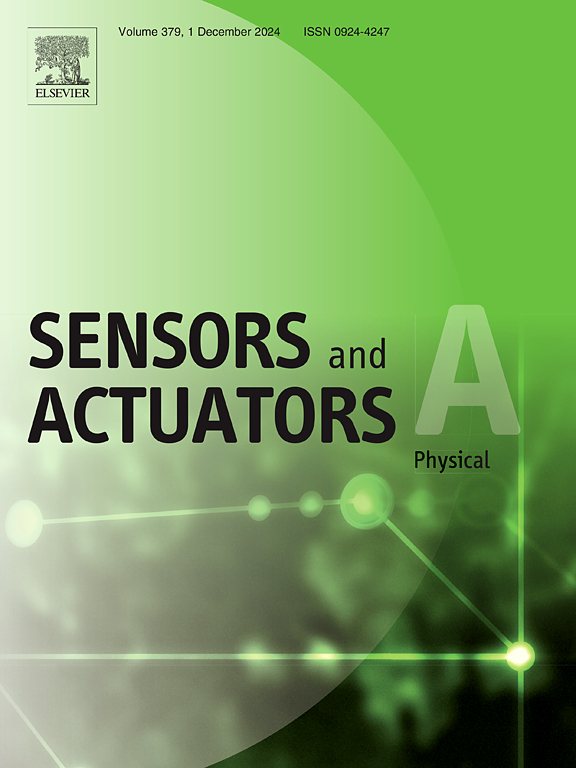Design of a miniature high-precision anemorumbograph based on thermal field distribution
IF 4.1
3区 工程技术
Q2 ENGINEERING, ELECTRICAL & ELECTRONIC
引用次数: 0
Abstract
Anemorumbograph has been widely utilized in aerospace, aviation, and meteorological monitoring. To achieve the portability and the miniaturization, the design of an anemorumbograph was presented in this research, which was based on fluid dynamics simulation and experimental validation. Firstly, the temperature fields on a plane under different flow conditions were analyzed with FLUENT. Therefore eight NTC thermistors around the central resistance wire were arranged on the sensor surface. Secondly, the responses of the eight NTC thermistors under the winds with various speeds and directions were recorded. Also the effect of the environmental temperature on the thermistors response was illustrated. Then an algorithm based on third-order Fourier series fitting and environmental temperature correction was proposed. Experimental validation with a manufactured sensor PCB with a size of 20 mm in diameter and a power consumption of 0.635 W. Anemorumbograph based on thermal field distribution was also performed through wind tunnel tests. The results demonstrated that the detection range of wind speed was 1–30 m/s ± (0.5 +0.03 v) m/s, and the detection range of wind direction was 0–360° with an accuracy of ± 5°. The sensor has good linearity within ambient temperature range of −10–40 ℃.
基于热场分布的微型高精度验血仪的设计
减震器已广泛应用于航天、航空和气象监测领域。为了实现便携性和小型化,本研究基于流体动力学模拟和实验验证,提出了减震器的设计方案。首先,利用 FLUENT 分析了不同流动条件下平面上的温度场。因此,在传感器表面布置了八个围绕中心电阻丝的 NTC 热敏电阻。其次,记录了八个 NTC 热敏电阻在不同风速和风向下的响应。此外,还说明了环境温度对热敏电阻响应的影响。然后提出了一种基于三阶傅里叶级数拟合和环境温度校正的算法。实验验证了直径为 20 毫米、功耗为 0.635 瓦的传感器印刷电路板。此外,还通过风洞试验进行了基于热场分布的失真记录。结果表明,风速检测范围为 1-30 m/s ± (0.5 +0.03 v) m/s,风向检测范围为 0-360°,精度为 ± 5°。传感器在 -10-40 ℃ 的环境温度范围内线性良好。
本文章由计算机程序翻译,如有差异,请以英文原文为准。
求助全文
约1分钟内获得全文
求助全文
来源期刊

Sensors and Actuators A-physical
工程技术-工程:电子与电气
CiteScore
8.10
自引率
6.50%
发文量
630
审稿时长
49 days
期刊介绍:
Sensors and Actuators A: Physical brings together multidisciplinary interests in one journal entirely devoted to disseminating information on all aspects of research and development of solid-state devices for transducing physical signals. Sensors and Actuators A: Physical regularly publishes original papers, letters to the Editors and from time to time invited review articles within the following device areas:
• Fundamentals and Physics, such as: classification of effects, physical effects, measurement theory, modelling of sensors, measurement standards, measurement errors, units and constants, time and frequency measurement. Modeling papers should bring new modeling techniques to the field and be supported by experimental results.
• Materials and their Processing, such as: piezoelectric materials, polymers, metal oxides, III-V and II-VI semiconductors, thick and thin films, optical glass fibres, amorphous, polycrystalline and monocrystalline silicon.
• Optoelectronic sensors, such as: photovoltaic diodes, photoconductors, photodiodes, phototransistors, positron-sensitive photodetectors, optoisolators, photodiode arrays, charge-coupled devices, light-emitting diodes, injection lasers and liquid-crystal displays.
• Mechanical sensors, such as: metallic, thin-film and semiconductor strain gauges, diffused silicon pressure sensors, silicon accelerometers, solid-state displacement transducers, piezo junction devices, piezoelectric field-effect transducers (PiFETs), tunnel-diode strain sensors, surface acoustic wave devices, silicon micromechanical switches, solid-state flow meters and electronic flow controllers.
Etc...
 求助内容:
求助内容: 应助结果提醒方式:
应助结果提醒方式:


